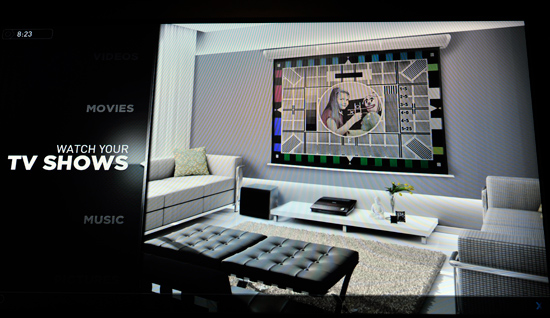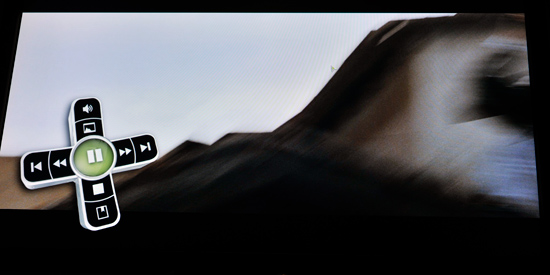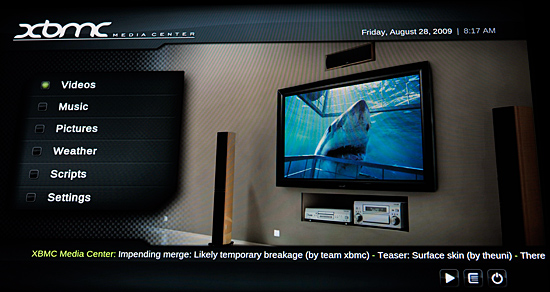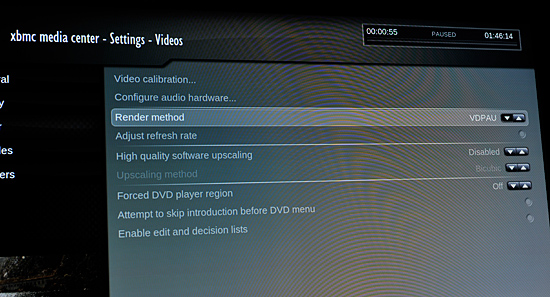Two New Ions: ASUS AT3N7A-I and ASRock Ion 330
by Anand Lal Shimpi on August 28, 2009 12:00 AM EST- Posted in
- Motherboards
Quick Usage Notes: Ion in Windows 7 and SSDs
Most of my Atom experience has happened under Windows XP, Vista and Linux in that order. Until the ASUS Ion board, I’d spent very little time with an Atom platform under Windows 7.
When I reviewed the Zotac board I ran all of my tests with an Intel SSD so I could compare the results to other CPUs in Bench. The SSD made the experience a lot more bearable since the only thing I ended up waiting on was the CPU, rather than the CPU and a slow hard drive. Under Windows 7, the combination is even more impressive.
I’m not sure if it’s just that the UI is snappier or the core parking and other threading enhancements in Windows 7 really shine on such a low performing processor, but the whole system is a lot more usable now.
I’m even using a slower Indilinx SSD this time around and the system actually feels decent. The only time you realize that you are very CPU bound is when installing or using an application that you’ve used previously on a modern desktop/notebook. Everything takes longer to run, but with a good SSD the system doesn’t feel nearly as slow as it actually is.
The worst combination is a slow hard disk that’s thrashing like crazy and a slow CPU that takes forever to do anything with the data its pulling off the disk. With these Ion platforms you’re stuck with the slow CPU, but fixing the disk problem seriously improves the overall experience. It won’t turn the Ion into a high end gaming machine, but it’ll make it a lot more bearable.
Ion Meets Linux: XBMC
My favorite thing about the first generation Microsoft Xbox? Xbox Media Player. Microsoft, like virtually all console makers, sold the Xbox at a loss in order to create a large install base. At the time, it meant you were getting a full fledged PC for under $300. Remember that this was in the time before netbooks and nettops, so you were getting a pretty good deal.
A community of smart folks realized that you could modify the original Xbox to run homebrew code. And it wasn’t too much longer before Xbox Media Player (XBMP) was born. Back then there weren’t many great ways of getting content on your PC to your TV; if you had an Xbox it was already hooked up to your TV, you just needed a way to stream videos. Xbox Media Player did that.
XBMP evolved into Xbox Media Center (XBMC) but the requirements of playing higher quality videos quickly outpaced what the Xbox’s 700MHz Celeron could muster. Today, the XBMC community is thriving and the software has been ported to Windows, OS X as well as Linux.

One of the default XBMC skins
NVIDIA enjoys particularly good driver support for Ion under Linux, including full support for hardware H.264 acceleration through VDAPU. I’d never tried XBMC on an Ion so I thought I’d give it a try on the ASUS board.

On screen controls while playing movies
Like most of these projects, XBMC is largely supported through a very active forum. This thread shows you how to install XBMC on the Acer Aspire Revo (an OEM Ion system). Thankfully the hardware is similar enough that the same methods also apply to the ASRock, ASUS and Zotac Ion boards as well.

Another default XBMC skin
I downloaded the XBMC Live image from here. That particular image already has NVIDIA drivers that properly recognize the Ion and enable hardware H.264 acceleration. It’s a Live image so you can boot from it directly without even touching your hard drive if you just want to try it out. Following the instructions in that thread, I had a fully usable XBMC setup in minutes. And to be honest, it was pretty sweet.

Hardware acceleration baby
The XBMC interface is great and skinnable. The default skin is clean and easy to use, but there are even more impressive options available on the web.

It works!
What impressed me most about the XBMC experience on Ion was how easy it was to setup and how fast the interface was. Obviously we’re still quite limited by the Atom processor, but this thing felt much quicker than when I tried MCE Video Browser on the Ion earlier this year. It didn’t actually feel sluggish; I saw some choppy transitions at times but it was totally usable. Not to mention much better than most UIs on traditional CE devices.
If you’re looking for a way to stream content to your TV, I’d strongly recommend giving XBMC a try on the Ion. It works very well and delivers a clean, easy to setup, easy to use HTPC experience that’s fully hardware accelerated by NVIDIA’s Ion.










61 Comments
View All Comments
cghebert - Friday, August 28, 2009 - link
Anand,While SSDs obviously offer a speed increase, you can't store that many movies on them. And, if you have a small ITX case, there might not be room for two drives. Are the ION systems fast enough to play HD movies over ethernet, or would the two drives need to be in the same case?
Thanks for the review btw!
GeorgeH - Friday, August 28, 2009 - link
Right now you can get Zotac's LGA775 Mini-ITX GF9300 for 119 AR. Couple that with a $50 E1500, and you've got a $169 system that will destroy these ION platforms for the exact same price. Similar options exist on the AMD side as well (think GF8200 + X2 240 Regor for ~$160.)Given that those options exist, a comparison with Atom would be awesome, especially one covering noise, power consumption, and case choices - i.e. could you build an LGA775 Mini-ITX in a similar form factor as the ASRock with comparable acoustics, or do you really need the ultra-low power consumption and TDP of an Atom CPU?
eversteegt - Tuesday, November 3, 2009 - link
Great, but are you sure the GF 9300 on that board has the same core with the same features (like playing Full HD 1080p video completely hardware-accelerated in Linux) as the GF9300 core on the ION platform? ;)Pandamonium - Friday, August 28, 2009 - link
That Zotac board doesn't support wake on USB quite yet, as far as I can tell. That's a pretty huge deal breaker for HTPC duty.Personally, I want something only powerful enough to handle streaming HD. If Adobe/nVidia get their act together and offload Flash scaling to the GPU, the Atom gets my vote for the reduced TDP. For a system that will be sitting in an enclosed TV stand (glass door style), a low TDP is absolutely necessary.
GeorgeH - Saturday, August 29, 2009 - link
If the Zotac board doesn't work for you, you can pick up an Intel G45 board for ~$5-10 less. As to the TDP, the idle power of a 5050e/780G system can be as low as 35-40W, or about the same as the Asus ION board - which leads me to believe that they're also producing comparable amounts of heat at idle or when doing IGP accelerated video playback.Obviously the 5050e is going to be more efficient than the examples I listed (which I couldn't find reputable and relevant numbers for) and will consume much more power than the Atom under full CPU load, but that's not the point. The point is that I'm not quite convinced that ION is necessary or even the best option unless you're going with ultra-slim designs such as the Aspire Revo.
cghebert - Friday, August 28, 2009 - link
That's an excellent point. I actually just built a micro-ATX Athlon X2+Radeon 4550 based system as my HTPC because I wanted a system that could play Hulu and other streaming internet videos, something that the ION would limit.Plus, one beef I have about most ITX cases (at least that don't come with a DC adapter for their power supply) is that they are TALL. Taller than a nice micro-ATX case, which fits much better amongst my HT gear.
One case that I didn't look at that is worth mention for the ION is this one http://www.mini-box.com/M350-universal-mini-itx-en...">http://www.mini-box.com/M350-universal-mini-itx-en...
from the same people that make the PICO psu.
I'd also like to see a comparison between ION systems and low power ITX systems built with Intel or AMD desktop chips.
TA152H - Friday, August 28, 2009 - link
Intel did a nice job with the processor, but we're stuck with either getting the miserable 945, or buying something from a crap company (NVIDIA) that is at least somewhat modern.What a terrible choice. I'd love to own an Atom based file server, but what kind of choice is this? I'm not stupid enough to buy NVIDIA, but then, what kind of choice is the grotesquely obsolete 945 chipset?
It has taken Intel far too long to come out with a reasonable solution to this problem. You could overlook it for a few months, or even half a year, but it's gone on far too long. It's a pity ATI didn't enter this market. You'd have nice performance, and it wouldn't be so frightening to buy a product from them.
Anand, why put the Pentium 4 in the power tests? They kind of came out of nowhere, and, actually used less power than I thought they would. You really seem to have a weird fascination with the Netburst processors; probably because they were so bad, they are interesting. I will say this though, if they had been built on 45nm, with the much better power characteristics of this process, they'd probably hit 6 GHz in their sleep. Meaning, they'd perform roughly like the 2.0 GHz Core 2 :-P.
eversteegt - Tuesday, November 3, 2009 - link
Why this "steep" comment about NVIDIA being crap?For Linux users (like me), NVIDIA is the ONLY quality option to play back hardware-accelerated video. AMD does not even get close to build stable graphics drivers for Linux, let alone hardware-accelerated HD video. I think NVIDIA ION is the only platforum that gives the Atom a right to exist....
strikeback03 - Monday, August 31, 2009 - link
Intel does have a more modern chipset for Atom (the US15) but almost no one is using it. Whether this is due to cost or another stupid Intel limitation I do not know.bh192012 - Friday, August 28, 2009 - link
What was WOW like after you OC CPU and GPU? Also, if someone someday decided to actually cool these things with something bigger than a 40mm fan, can you hit 2.2 ghz etc.